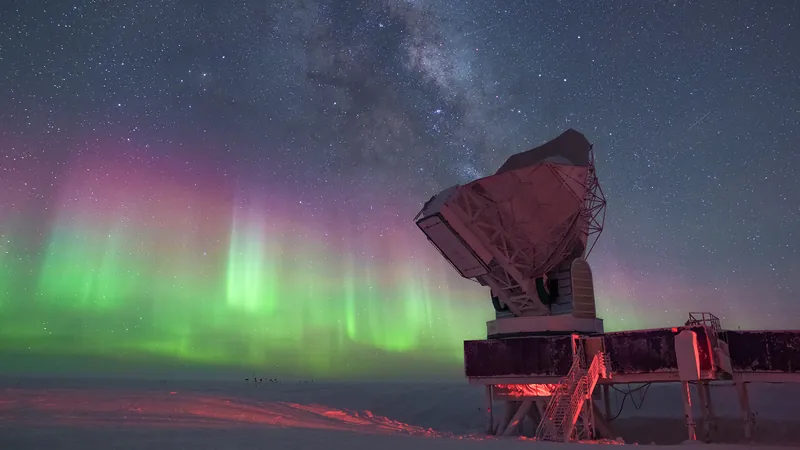
Groundbreaking Discoveries from the South Pole Telescope Revolutionize Our Understanding of the Universe!
2024-11-13
Author: Yu
Groundbreaking Discoveries from the South Pole Telescope Revolutionize Our Understanding of the Universe!
In a monumental leap for cosmology, new research conducted by a team from UC Davis and the South Pole Telescope collaboration is shedding light on the universe's mysterious past. This study focuses on the Cosmic Microwave Background (CMB), the faint afterglow of the Big Bang that has traveled across the cosmos for nearly 14 billion years.
Approximately 400,000 years post-Big Bang, the universe had cooled sufficiently to allow light to escape the dense primordial soup. This ancient light, crucial for astronomers, is known as the Cosmic Microwave Background. Utilizing observational data collected at the South Pole Telescope, which operates within the chilly confines of Antarctica's Amundsen-Scott South Pole Station, the researchers sought to refine the standard cosmological model that narrates the universe's evolution over eons.
Detailed measurements of the CMB's polarized light further validate the current cosmological framework. Not only does this study corroborate earlier findings, but it also proposes a novel calculation of the Hubble constant, addressing the puzzling issue of 'Hubble tension,' which reflects ongoing discrepancies over the rate of the universe's expansion.
Lloyd Knox, a cosmologist and one of the study's co-authors, emphasized the significance of their findings: 'We have a coherent and successful model capturing 14 billion years of cosmic evolution. However, the origins of the initial cosmic structures that led to the universe as we know it remain elusive.'
Unlocking the Mysteries of the Early Universe
The research involved a meticulous examination of two years of polarized light data captured from the South Pole Telescope between 2019 and 2020. These observations encompassed an impressive 1,500 square degrees of the sky, providing the team a comprehensive view of mass distribution in the universe.
Interestingly, light is normally unpolarized, oscillating in various directions. However, phenomena such as sunlight reflecting off water create polarized light—a principle revisited by researchers as they examined the early CMB photons. The team skilfully mapped the polarization to reveal how gravitational forces distort the paths of light, a phenomenon known as gravitational lensing.
Employing advanced supercomputing resources at the National Energy Research Scientific Computing Center (NERSC) in Berkeley, the researchers simulated potential universal models to see how well they could replicate the observed polarized light.
Fei Ge, a leading graduate researcher, stated, 'We strive to develop models that can accurately predict the universe's observable characteristics.' This intersection of data and modeling is crucial for understanding not just the past but also the present state of the cosmos.
The Hubble Tension Conundrum
Central to this research is the pressing issue of the Hubble tension, where differences in the universe's expansion rate contribute to a significant scientific dilemma. Current methodologies produce conflicting results: while one approach uses the CMB's properties per the standard cosmological model, another leverages observations of distant stars and supernovae, which typically yield a faster expansion rate.
The new polarization data aligns closely with CMB intensity predictions from NASA's Planck satellite, suggesting a significant breakthrough in this ongoing debate. However, the results starkly contrast higher supernova measurements, establishing a crucial analytical juncture for understanding cosmic dynamics.
With precise measurements that challenge existing records, this study provides a bold avenue for future research into the very fabric of our universe. In what promises to be an exciting era for cosmology, researchers continue to push the boundaries of our understanding, tackling one of the most profound mysteries in science.
As we ponder the universe's intricate tapestry, these findings spark curiosity and remind us of the endless quests that lie ahead in unraveling the cosmos's secrets. Keep an eye on the skies—who knows what revelations await just beyond our reach?


 Brasil (PT)
Brasil (PT)
 Canada (EN)
Canada (EN)
 Chile (ES)
Chile (ES)
 España (ES)
España (ES)
 France (FR)
France (FR)
 Hong Kong (EN)
Hong Kong (EN)
 Italia (IT)
Italia (IT)
 日本 (JA)
日本 (JA)
 Magyarország (HU)
Magyarország (HU)
 Norge (NO)
Norge (NO)
 Polska (PL)
Polska (PL)
 Schweiz (DE)
Schweiz (DE)
 Singapore (EN)
Singapore (EN)
 Sverige (SV)
Sverige (SV)
 Suomi (FI)
Suomi (FI)
 Türkiye (TR)
Türkiye (TR)